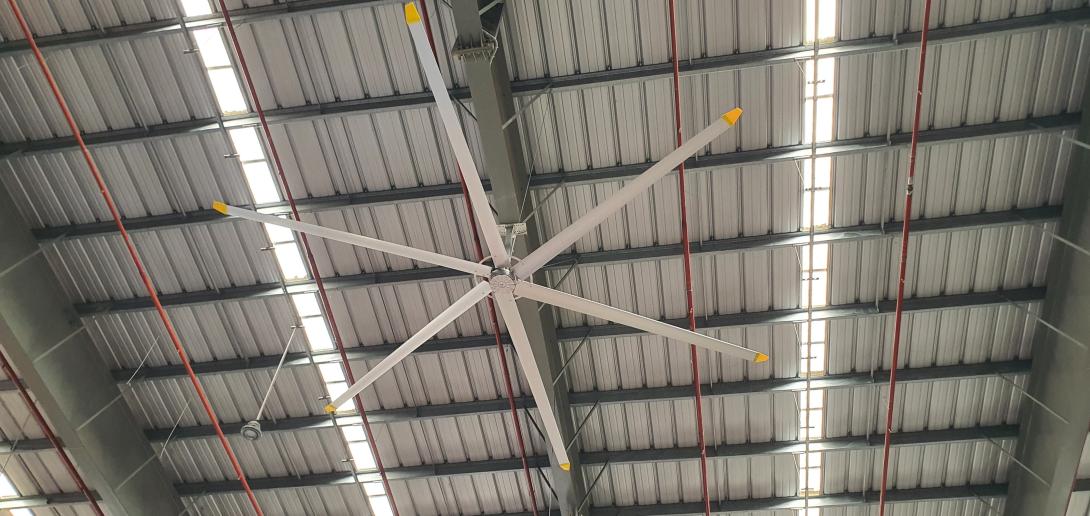
Introduction
In large industrial spaces such as warehouses, factories, and distribution centers, temperature control is a major challenge. Traditional cooling and heating methods often fall short in providing uniform air circulation, leading to hot and cold spots, high energy costs, and reduced worker comfort. This is where High-Volume, Low-Speed (HVLS) fans come into play. These large-diameter fans are designed to optimize airflow, providing efficient cooling in hot weather and effective heat distribution in colder months.
What Are HVLS Fans?
HVLS fans are industrial ceiling fans that typically range from 7 to 24 feet in diameter. Unlike conventional high-speed fans, which rely on rapid rotations to move air, HVLS fans operate at low speeds to create a large column of slow-moving air. This unique mechanism allows for consistent and widespread air circulation, effectively regulating indoor temperatures while reducing energy consumption.
Cooling Benefits of HVLS Fans
During warmer months, excessive heat buildup can make industrial workspaces uncomfortable and unsafe. HVLS fans address this issue by generating a cooling effect through increased air movement. Here are some key cooling benefits:
- Evaporative Cooling: HVLS fans promote sweat evaporation by moving a large volume of air across surfaces, helping to reduce the perceived temperature by up to 10°F.
- Elimination of Hot Spots: Stagnant air leads to uneven temperature distribution. HVLS fans continuously mix the air, ensuring uniform cooling throughout the facility.
- Improved Ventilation: By working in tandem with HVAC systems and open windows, HVLS fans enhance fresh air exchange, reducing humidity and preventing the buildup of airborne contaminants.
- Energy Efficiency: Instead of relying solely on air conditioning, facilities can use HVLS fans to reduce HVAC workload, leading to significant energy savings.
Heat Control with HVLS Fans
In colder months, heat naturally rises to the ceiling, leaving ground-level areas much cooler. This phenomenon, known as thermal stratification, results in energy inefficiency and discomfort. HVLS fans help address this problem through a process called destratification:
- Even Heat Distribution: By gently pushing warm air down from the ceiling to occupied levels, HVLS fans ensure consistent temperatures throughout the space.
- Reduced Heating Costs: Facilities can lower thermostat settings without compromising comfort, leading to substantial savings on heating bills.
- Condensation Prevention: By maintaining consistent air movement, HVLS fans help reduce condensation on surfaces, which can be particularly beneficial in industries dealing with moisture-sensitive products.
Industries That Benefit from HVLS Fans
HVLS fans are widely used across various industries due to their versatility and effectiveness. Some common applications include:
- Warehouses and Distribution Centers: Ensuring worker comfort while preventing product spoilage and machinery overheating.
- Manufacturing Plants: Maintaining consistent air quality and temperature for better productivity and safety.
- Agricultural Facilities: Providing proper ventilation for livestock and crops, reducing heat stress and mold growth.
- Airplane Hangars: Regulating temperature fluctuations in large open spaces to protect equipment and personnel.
- Gymnasiums and Sports Arenas: Enhancing airflow for better athlete performance and audience comfort.
Choosing the Right HVLS Fan
Selecting the appropriate HVLS fan depends on several factors:
- Facility Size: The larger the space, the bigger the fan diameter required.
- Ceiling Height: HVLS fans are most effective when mounted at an optimal height to maximize air circulation.
- Motor Type: Direct-drive motors are quieter and require less maintenance compared to traditional gearbox motors.
- Control Options: Many HVLS fans come with programmable settings, remote control, and integration with building automation systems for increased convenience.
- Energy Efficiency Ratings: Choosing energy-efficient models helps maximize savings on electricity costs.
Conclusion
HVLS fans are a game-changer for industrial spaces struggling with temperature control. By offering superior air circulation, they improve cooling efficiency in hot months and enhance heat distribution in colder months. This dual benefit not only enhances worker comfort but also significantly reduces energy costs, making HVLS fans a smart investment for businesses looking to optimize their facility’s climate control. Whether in warehouses, factories, or agricultural settings, HVLS fans provide an effective and sustainable solution for maintaining ideal indoor environments year-round.
